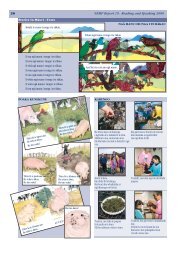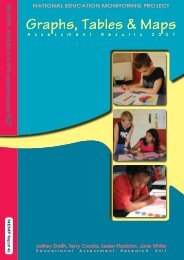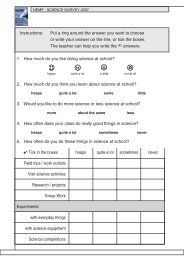mathematics
Mathematics 2001.pdf [33.7 MB] - NEMP - University of Otago
Mathematics 2001.pdf [33.7 MB] - NEMP - University of Otago
- No tags were found...
Create successful ePaper yourself
Turn your PDF publications into a flip-book with our unique Google optimized e-Paper software.
Chapter 2: Assessing Information Skills 11<br />
➢ Materials for tasks need to be sufficiently portable,<br />
economical, safe and within the handling capabilities<br />
of students. Task materials also need to have<br />
meaning for students.<br />
➢ The time needed for completing an individual task<br />
has to be balanced against the total time available<br />
for all of the assessment tasks, without denying<br />
students sufficient opportunity to demonstrate<br />
their capabilities.<br />
➢ Each task needs to be capable of sustaining the<br />
attention and effort of students if they are to<br />
produce responses that truly indicate what they<br />
know and can do. Since neither the student nor<br />
the school receives immediate or specific feedback<br />
on performance, the motivational potential<br />
of the assessment is critical.<br />
➢ Tasks need to avoid unnecessary bias on the<br />
grounds of gender, culture or social background<br />
while accepting that it is appropriate to have<br />
tasks that reflect the interests of particular groups<br />
within the community.<br />
National monitoring <strong>mathematics</strong> assessment<br />
tasks and survey<br />
One hundred and one <strong>mathematics</strong> tasks were administered,<br />
together with an interview questionnaire that<br />
investigated students’ interests, attitudes and involvement<br />
in <strong>mathematics</strong>.<br />
Thirty-seven tasks were administered in one-to-one interview<br />
settings, where students used materials and visual<br />
information. Two tasks were presented in team or group<br />
situations involving small groups of students working<br />
together. Twenty-four tasks were attempted in a stations<br />
arrangement, where students worked independently on<br />
a series of tasks, some presented on lap-top computers.<br />
The final thirty-eight tasks were administered in an independent<br />
approach, where students sat at desks or tables<br />
and worked through a series of paper-and-pencil tasks.<br />
Forty-three of the tasks were identical for year 4 and<br />
year 8 students. A further twenty-eight tasks included<br />
common components for both years, together with more<br />
challenging components for year 8 students and/or less<br />
demanding components for year 4 students. Of the<br />
remaining tasks, seven were specifically for year 4 students<br />
and twenty-three for year 8 students. Some of these<br />
single year tasks had parallel tasks at the other level, but<br />
with different stimulus material or significantly different<br />
instructions.<br />
Trend Tasks<br />
Thirty of the tasks were previously used, entirely or<br />
in part, in the 1997 <strong>mathematics</strong> assessments. These<br />
were called link tasks in the 1997 report, but were not<br />
described in detail to avoid any distortions in the 2001<br />
results that might have occurred if the tasks had been<br />
widely available for use in schools since 1997. In the<br />
current report, these tasks are called trend tasks and are<br />
used to examine trends in student performance: whether<br />
they have improved, stayed constant or declined over the<br />
four year period since the 1997 assessments.<br />
Link Tasks<br />
To allow comparisons between the 2001 and 2005 assessments,<br />
thirty-six of the tasks used for the first time in<br />
2001 have been designated link tasks. Results of student<br />
performance on these tasks are presented in this report,<br />
but the tasks are described only in general terms because<br />
they will be used again in 2005.<br />
Marking methods<br />
The students’ responses were assessed using specially<br />
designed marking procedures. The criteria used had<br />
been developed in advance by Project staff, but were<br />
sometimes modified as a result of issues raised during the<br />
marking. Tasks that required marker judgement and were<br />
common to year 4 and year 8 were intermingled during<br />
marking sessions, with the goal of ensuring that the same<br />
scoring standards and procedures were used for both.<br />
Task by task reporting<br />
National monitoring assessment is reported task by task<br />
so that results can be understood in relation to what the<br />
students were asked to do.<br />
Access Tasks<br />
Teachers and principals have expressed considerable<br />
interest in access to NEMP task materials and marking<br />
instructions, so that they can use them within their own<br />
schools. Some are interested in comparing the performance<br />
of their own students to national results on some<br />
aspects of the curriculum, while others want to use tasks<br />
as models of good practice. Some would like to modify<br />
tasks to suit their own purposes, while others want to<br />
follow the original procedures as closely as possible.<br />
There is obvious merit in making available carefully<br />
developed tasks that are seen to be highly valid and<br />
useful for assessing student learning.<br />
Some of the tasks in this report cannot be made available<br />
in this way. Link tasks must be saved for use in four<br />
years time, and other tasks use copyright or expensive<br />
resources that cannot be duplicated by NEMP and provided<br />
economically to schools. There are also limitations<br />
on how precisely a school’s administration and marking<br />
of tasks can mirror the ways that they are administered<br />
and marked by the Project. Nevertheless, a substantial<br />
number of tasks are suitable to duplicate<br />
for teachers and schools. In this report, these<br />
access tasks are identified with the symbol above, and<br />
can be purchased in a kit from the New Zealand Council<br />
for Educational Research (P.O. Box 3237, Wellington<br />
6000, New Zealand). Teachers are also encouraged to<br />
use the NEMP web site (http://nemp.otago.ac.nz) to<br />
view video clips and listen to audio material associated<br />
with some of the tasks.






